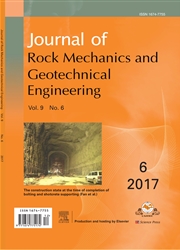

 中文摘要:
中文摘要:
This paper focuses on the evolution processes of different types of rockbursts occurring in deep tunnels. A series of laboratory tests and in-situ monitoring in deep tunnels excavated by tunnel boring machine (TBM) and drill-and-blast (D&B) method have been conducted to understand the mechanisms and processes of the evolution of different types of rockbursts, including strain rockburst, strain-structure slip rockburst, immediate rockburst and time-delayed rockburst. Three different risk assessment methods are proposed to evaluate the intensity and potential failure depth of rockbursts. These methods can be applied before excavation and the results can be updated according to the real-time information during excavation. Two micro-seismicity based real-time warning systems have been established for predicting various intensities of rockbursts, such as slight, moderate, intensive and extremely intensive rockbursts. Meanwhile, the probability and intensity of the rockburst are also given. The strategy for excavation and support design has been suggested for various intensities of rockbursts before excavation. The strategy for dynamic control of the rockburst evolution process is also proposed according to the monitoring results. The methodology has been successfully applied to rockburst risk reduction for deep tunnels at Jinping II hydropower project. The results have illustrated the applicability of the proposed methodology and techniques concerning rockbursts.
 英文摘要:
英文摘要:
This paper focuses on the evolution processes of different types of rockbursts occurring in deep tunnels. A series of laboratory tests and in-situ monitoring in deep tunnels excavated by tunnel boring machine (TBM) and drill-and-blast (D&B) method have been conducted to understand the mechanisms and processes of the evolution of different types of rockbursts, including strain rockburst, strain-structure slip rockburst, immediate rockburst and time-delayed rockburst. Three different risk assessment methods are proposed to evaluate the intensity and potential failure depth of rockbursts. These methods can be applied before excavation and the results can be updated according to the real-time information during excavation. Two micro-seismicity based real-time warning systems have been established for predicting various intensities ofrockbursts, such as slight, moderate, intensive and extremely intensive rockbursts. Meanwhile, the probability and intensity of the rockburst are also given. The strategy for excavation and support design has been suggested for various intensities of rockbursts before excavation. The strategy for dynamic control of the rockburst evolution process is also proposed according to the monitoring results. The methodology has been successfully applied to rockburst risk reduction for deep tunnels at Jinping II hydropower project. The results have illustrated the applicability of the proposed methodology and techniques concerning rockbursts.
 同期刊论文项目
同期刊论文项目
 同项目期刊论文
同项目期刊论文
 期刊信息
期刊信息
